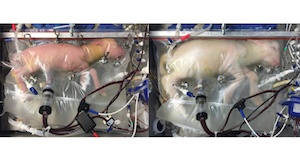International Prematurity Awareness Day
 The 17th of November marks International Prematurity Awareness Day . This day was brought to life in 2008 by the European Foundation for the care of Newborn Infants (EFCNI). This foundation aims to support and improve the lives of prematurely born children and their families. These children and families need all the support they can get, because the prevalence of preterm birth, 37 weeks of gestation or less, is significant. One in ten babies worldwide is born preterm and preterm birth accounts for 16% of mortality in children under the age of 5 worldwide. The challenge to improve this situation lies in the fact that it is impossible to perform fetal studies in humans. There is, however, light on the horizon!
The 17th of November marks International Prematurity Awareness Day . This day was brought to life in 2008 by the European Foundation for the care of Newborn Infants (EFCNI). This foundation aims to support and improve the lives of prematurely born children and their families. These children and families need all the support they can get, because the prevalence of preterm birth, 37 weeks of gestation or less, is significant. One in ten babies worldwide is born preterm and preterm birth accounts for 16% of mortality in children under the age of 5 worldwide. The challenge to improve this situation lies in the fact that it is impossible to perform fetal studies in humans. There is, however, light on the horizon!
In this blog I would like to introduce you to the fetal sheep models that has helped scientist and clinicians worldwide to better understand pregnancies, the physiological processes involved that may cause preterm birth and explain to you why these models are most suitable for fetal research.
In contrast to cardiovascular research where porcine models are often used due to their similarities to human anatomy, developmental processes are more accurately tracked in sheep. A complete review explaining the appropriateness of sheep models was published in 2018, but here I would like to highlight the most important arguments.
- Sheep and humans share similar prenatal patterns of precocial brain and cardiovascular development; the offspring of some sheep breeds (Welsh Mountain, Merino) have similar birth weights to full-term human babies.
- Development of major organ and regulatory systems occurs before and around birth in sheep, as in humans, but after birth in rodents.
- Many important placental physiological characteristics are shared between sheep and humans.
- Sheep are an important model of glucose metabolism during pregnancy and the programming effects of an adverse uterine environment on glucose metabolism in the offspring.
- Surgical instrumentation to study fetal development over long periods of time, as needed for translating outcomes to humans, is achievable in sheep because humans and sheep give birth to one offspring at a time.
Acute instrumentation, with special emphasis on blood flow and pressure-volume (PV) loop data has yielded invaluable information regarding neonatal cardiac function. As examples, I would like to highlight two recent studies.
When we look at congenital heart disease, we often also observe pulmonary hypertension. What is interesting is that patients with preserved right ventricular (RV) function have a better outcome. Studies performed in lambs, using RV pressure-volume catheters and flow probes on the pulmonary verified the mechanism behind the benefits of superior RV performance; therefore, expanding therapy alternatives to support RV function rather than solely focusing on the progression of pulmonary vascular pathology.
The second acute neonatal study, performed in lambs, investigated the effectiveness of O2 delivery biotherapeutic in cardiac function during acute hypoxic states. Acute hypoxia triggers a compensatory increase in CO as an attempt deliver appropriate O2 to tissues. It is important to notice here how critical this is, since the rise in CO demands extra O2 consumption from the heart that is distinctively O2 dependent to maintain contractile function. The use of biventricular catheters for PV loop analyses in both ventricles uncovered the therapeutic efficacy of a novel biotherapeutic agents by maintained RV and left ventricle (LV) contractile function during acute hypoxia induction.
At Transonic, we also have years of experience in chronic surgical instrumentation, specifically through the use chronic perivascular flow probes to measure blood flow during gestation. Not only the mother sheep, but also the fetus is sufficiently resilient and large to permit implantation of perivascular flow probes for in vivo recording of cardiovascular variables and electrical signals. In addition, blood sampling for endocrine and metabolic measurements over long periods can be part of these studies.
In fetal sheep, Transonic Flowprobes have been applied to the pulmonary, iliac, femoral, umbilical and carotid arteries for direct measurements of their respective flows. For each of these applications we have a free to download surgical protocol available.
A real break-through was published in 2017 when Partridge et al. introduced the public to their extra-uterine system that allows full study and support of a growing fetal sheep.
Extreme prematurity is the leading cause of neonatal mortality in the developed world due to a combination of organ immaturity and iatrogenic injury. This extra-uterine system has been supporting fetal lambs that are developmentally equivalent to the extreme premature human infant for up to 4 weeks. Lambs on this systems support maintain stable haemodynamics, have normal blood gas and oxygenation parameters and maintain patency of the fetal circulation. With appropriate nutritional support, lambs on this system demonstrate normal somatic growth, lung maturation and brain growth and myelination.

Our perivascular flow probes have been part of this unique set-up from the beginning and are still part of this research today, allowing for new insights in the fetal biology and thus improving outcomes for preterm born babies that deserve all of our support. Not just on International Prematurity Awareness Day but every day!
If you are also developing a unique research model and believe that flow, pressure, or pressure-volume measurements will make your research more valuable, get in touch! We can’t wait to help you collect the high-quality data your research deserves.



